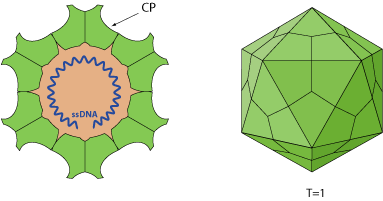VIRION

Non-enveloped, round, T=1 icosahedral symmetry, 18-26 nm in diameter. The capsid consists of 60 copies of CP protein.
GENOME
Linear, ssDNA genome of about 4 to 6 kb in size. Both positive and negative strands are encapsidated, although the percentage of particles encapsidating the positive strand can be lower depending on the host cell. MVM packages predominantly negative-sense single strands, while LuIII encapsidates strands of both polarities with equal efficiency. ORFs for both the structural and non-structural proteins are located on the same DNA strand.
The genome is replicated through rolling-hairpin mechanism.
GENE EXPRESSION
Host proteins transcribe the genomes into mRNAs. Alternative splicing allows expression of both structural and non-structural proteins.
ENZYMES
REPLICATION
NUCLEAR
- Attachement to host receptors initiates clathrin-mediated endocytosis of the virion into the host cell.
- The virion penetrates into the cytoplasm via permeabilization of host endosomal membrane.
- Microtubular transport of the virion toward the nucleus.
- The viral ssDNA genome penetrates into the nucleus.
- The ssDNA is converted into dsDNA by cellular proteins.
- dsDNA transcription gives rise to viral mRNAs when host cell enters S phase and translated to produce viral proteins.
- Replication occurs through rolling-hairpin mechanism, with NS1 endonuclease binding covalently to the 5' genomic end.
- Individual ssDNA genomes are excised from replication concatemers by a process called junction resolution.
- These newly synthesized ssDNA can either
a) be converted to dsDNA and serve as a template for transcription/replication
b) be encapsidated to form new virions that are released by cell lysis.


